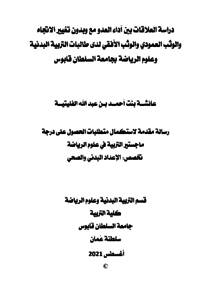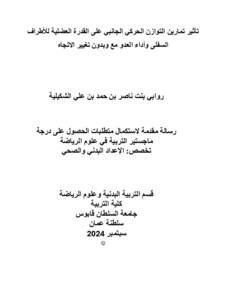وثيقة
دراسة العلاقات بين أداء العدو مع وبدون تغيير الاتجاه والوثب العمودي والوثب الافقي لدى طالبات التربية البدنية وعلوم الرياضة بجامعة السلطان قابوس.
عناوين أخرى
Relationships between sprint with and without change of direction and jumping abilities in female physical education students at Sultan Qaboos University
الناشر
جامعة السلطان قابوس.
ميلادي
2021
اللغة
العربية
الملخص الإنجليزي
Purpose. The aim of this study was to assess the relationships between sprint with and without change of direction and jumping abilities in female physical education students at Sultan Qaboos University. Methods. Twenty-eight female students participated in this study. They were tested on three occasions, separated by periods of 2 days. After tests familiarization, they performed six types of jumping test: Squat Jump, Countermovement Jump, Drop Jump, Horizontal Jump, Five Jump test, Three Jump test; and two types of Sprinting test: 20m on line and 20m with change of direction (4*5m). Results. The study showed the following results: No significant relationship between sprint 20m on line and sprint 20m with change of direction (4*5m), a significant correlation between performance of sprint on line and Countermovement Jump (p>0.005) and reactive strength index (p<0.001), no relationship between performance in sprint on line and horizontal Jumping, a significant correlation between performance in sprint with change of direction and Horizontal Jump (p<0.005) and Five Jump (p<0.005). On the other hand, the results showed that reactive strength index (RSI) can predict 40% of the performance in sprint 20m on line. When the RSI was associated with the Eccentric utilization ratio, they can predict 55% of the performance in sprint 20m on line (p<0.008). Conclusion. sprints on line and with change of direction have different physical demands and each one has its own features and requirements. The stretch- shortening cycle and the explosive strength can be considered as two essential parameters for developing performance in sprint with and without change of direction.
المجموعة
URL المصدر
الملخص العربي
هدف هذا البحث إلى دراسة العلاقات بين العدو مع وبدون تغيير الاتجاه والوثب العمودي والوثب الأفقي لدى طالبات التربية البدنية وعلوم الرياضة بجامعة السلطان قابوس. تكونت عينة الدراسة من طالبات السنة الثالثة والرابعة من قسم التربية البدنية وعلوم الرياضة والبالغ عددهن28 طالبة. استخدمت الباحثة المنهج الوصفي الارتباطي. قام جميع أفراد عينة البحث بتنفيذ اختبارات الوثب العمودي بالتمهيد والوثب العمودي بدون حركة تمهيدية والوثب العريض والوثب العميق والوثب العميق الأفقي والوثب العميق العمودي واختباري الوثب الثلاثي والوثب الخماسي واختبار العدو في خط مستقيم 20متر واختبار العدو مع تغيير الاتجاه 4?5. أظهرت الدراسة النتائج التالية: عدم وجود علاقة ارتباطية بين العدو في خط مستقيم والعدو مع تغيير الاتجاه، وجود علاقة طردية بين أداء العدو في خط مستقيم وكل من الوثب العمودي بالتمهيد(p<0.005) ومؤشر المطاطية (p<0.001)، عدم وجود علاقة بين أداء العدو في خط مستقيم وجميع مؤشرات الوثب الأفقي، وجود علاقة ارتباطية بين أداء العدو مع تغيير الاتجاه وكل من الوثب العريض(p<0.005) والوثب الخماسي(p<0.005). ومن جهة أخرى، بينت النتائج أن مؤشر المطاطية يتنبأ بنسبة %40 من أداء العدو في خط مستقيمp=0.001))، وأن مؤشر المطاطية ومؤشر القوة الانفجارية الأفقية من ارتفاع القفز يمكنان معا من التنبؤ بنسبة %55 من أداء العدو في خط مستقيم(p=0.008).
خلصت الدراسة الحالية الى أن أداء العدو مع وبدون تغيير الاتجاه هما متطلبين بدنيين مختلفين عن بعضهما البعض. وأن دورة الاطالة والتقصير والقوة الانفجارية يعتبران من أهم العناصر التي يجب العمل على تطويرها لتحسين أداء العدو مع وبدون تغيير الاتجاه.
خلصت الدراسة الحالية الى أن أداء العدو مع وبدون تغيير الاتجاه هما متطلبين بدنيين مختلفين عن بعضهما البعض. وأن دورة الاطالة والتقصير والقوة الانفجارية يعتبران من أهم العناصر التي يجب العمل على تطويرها لتحسين أداء العدو مع وبدون تغيير الاتجاه.
قالب العنصر
الرسائل والأطروحات الجامعية


